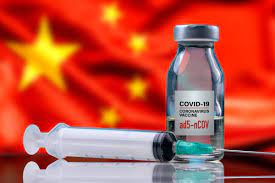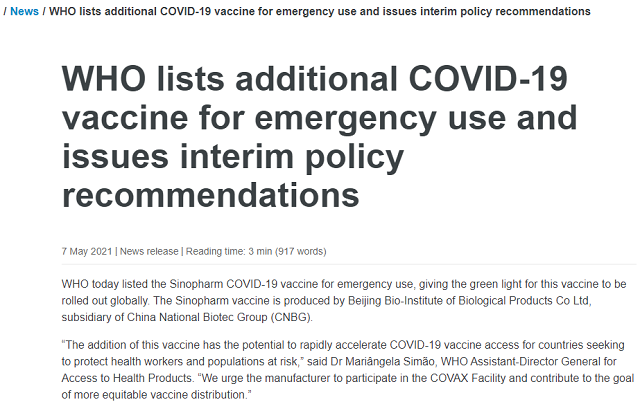WHO Listed Chinese Vaccine for Emergency Use

On the 7th local time, the World Health Organization (WHO) issued a statement announcing that the new crown vaccine developed by the Beijing Institute of Biological Products of China National Pharmaceutical Group will be included in the “Emergency Use List” (EUL).
The WHO Emergency Use List (EUL) is a prerequisite for the provision of vaccines to COVAX facilities. The list also allows countries to expedite their regulatory approvals to import and manage the new coronavirus vaccine.
The WHO stated in a statement that the WHO Strategic Advisory Expert Group on Immunization (SAGE) has also completed its review of the vaccine.

According to the WHO, based on all available evidence, the WHO recommends that the vaccine be administered at two doses, three to four weeks apart, for adults 18 and over. If all ages are combined, the effectiveness of the vaccine against symptomatic and hospitalized diseases is estimated to be 79%. adSize = 336.
The WHO stated that EUL assesses the quality, safety and effectiveness of the new crown vaccine, as well as the applicability of risk management plans and procedures (such as cold chain requirements). The evaluation is carried out by the product evaluation team, which is composed of regulatory experts and technical advisory groups (TAG) from all over the world, responsible for the risk-benefit assessment, on “whether the vaccine can be classified as an emergency vaccine” and “if It can be classified as an emergency vaccine, and under what conditions will it make independent recommendations.
- Prevent Coronavirus Spreading With Right Mask: 3 Points to Know
- Steps to help prevent the spread of COVID-19 if you are sick
- Test Kit for Coronavirus: SARS-CoV-2 Nucleic Acid Detection Kit (Rapid PCR Fluorescence Method)
- Symptoms (COVID-19)
- How does ZeroVirus protect us from virus?
The WHO stated in the statement that for the Sinopharm vaccine, the WHO organization’s assessment also includes on-site inspections of production facilities.
According to the WHO, the Sinopharm vaccine is an inactivated vaccine called SARS-CoV-2 vaccine. The vaccine is easy to store, which makes it ideal for resource-poor environments.
At the same time, Sinopharm Vaccine is also the first vaccine with a vaccine bottle monitor. The small label on the vaccine bottle will change color when the vaccine is exposed to heat, so that health workers know whether the vaccine can be used safely.
As mentioned earlier, SAGE has completed its review of the vaccine. The WHO also pointed out that very few elderly people (over 60 years old) participate in clinical trials, so the efficacy of this age group cannot be estimated.
Nevertheless, the WHO does not recommend setting an upper age limit for the vaccine, because preliminary data and supporting immunogenicity data indicate that the vaccine is likely to have a protective effect on the elderly.
According to the WHO, theoretically, there is no reason to believe that the vaccine has different safety profiles between the elderly and the young. Therefore, the WHO recommends that countries where the vaccine is used by the elderly should conduct safety and effectiveness monitoring to enhance the strength of this recommendation.
Prior to this, on May 3, the WHO had released an evaluation report on the Beijing Biovaccine BBIBP-CorV and other vaccines of China National Pharmaceutical Group.
At that time, the WHO confirmed in the report that the BBIBP-CorV vaccine has a high protective effect (78.1%) for people aged 18 to 59 years old. The evidence of vaccine effectiveness is “highly credible”, the effectiveness of preventing hospitalization is 78.7%, and the evidence of safety is “Medium credibility.”
